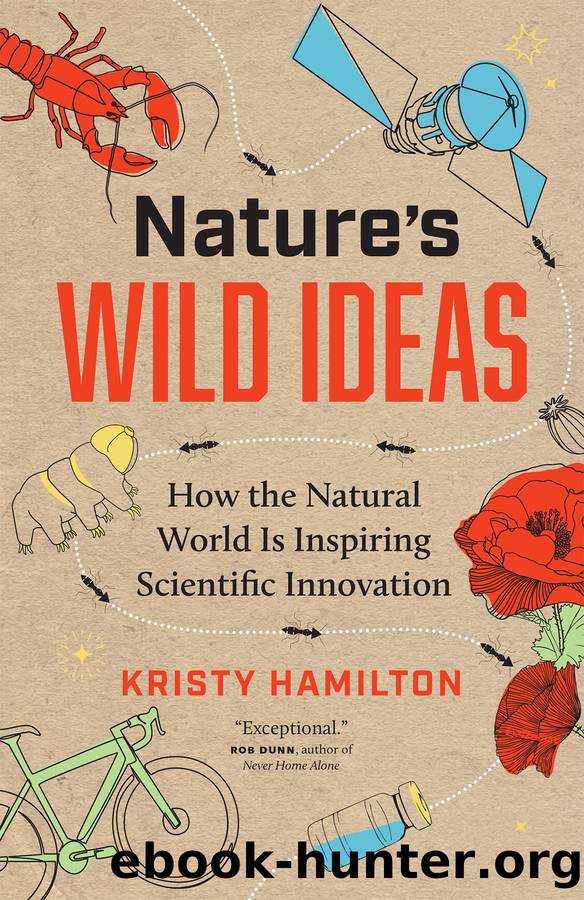Nature's Wild Ideas: How the Natural World is Inspiring Scientific Innovation by Kristy Hamilton

Author:Kristy Hamilton
Language: eng
Format: epub
Publisher: Greystone Books
Published: 2022-01-15T00:00:00+00:00
The Bare Bones
WHEN I FIRST visited the archives at the California Academy of Sciences, my purpose was purely investigative. I was there to introduce myself to their scientists so they could contact me if an illegally traded specimen was seized by police and sent to their department. At the time I was doing research into wildlife crimes, but a year later, bones cropped up again in my life, this time as I was researching material for this book. A silver-haired man with dark glasses named Jeff Brennan shared with me how our bones are inspiring engineers and designers to make lighter inventions. The story begins in the early 1990s, when a younger, darker-haired Brennan was a student all lined up to go to medical school. His trajectory was perfectly optimized: he had taken all his required courses, had dissected cadavers for his anatomy class, and was working on artificial limbs and prosthetics for amputees. Then there came a point where he realized this wasnât his dream. He transferred to the University of Michigan to do a PhD in orthopedic biomechanics, investigating how our bones grow and remodel.
The idea that you could somehow mimic the efficiency formula of bones using mathematics transfixed Brennan, and he began collaborating with his professor, Scott Hollister, and Dr. Noboru Kikuchi, who was one of the founding fathers of topology optimization, a method to mathematically optimize the layout of a material within certain design parameters. In the late eighties, Kikuchi was trying to model how the human body grows bone, and whether there was an optimal solution to its layout. Does the body follow rules in how it responds to stresses and strains? Could he translate the growth patterns of bones into a mathematical formula? If researchers could model how bone grows, perhaps they could use that knowledge to stimulate healthier bone growth in later life. This could help those with, for example, osteoporosis, a disease in which bones become brittle, and a common condition in women after menopause.
The hope was to develop a therapeutic tool, but the kernel of an idea took on a life of its own. Attempts to enter the medical innovation market are notoriously slow due to the many regulatory hurdles that must be cleared in order to establish the safety of new devices. Brennan didnât want to wait that long. He wondered whether we could use this mathematical formula for something other than the medical world. After graduate school, he went on the hunt for a job where a bone-inspired formula could be put to good use. One of the employers he came across was Altair, a young company that provided software and cloud solutions. Altair was the riskiest of the three companies that Brennan was looking into because they were relatively young, and the field of topology optimization was nascent, but they shared a common vision. Brennan and Jim Brancheau, chief technology officer, âspoke about the possibility that in the future, you could use this type of math to grow
Download
This site does not store any files on its server. We only index and link to content provided by other sites. Please contact the content providers to delete copyright contents if any and email us, we'll remove relevant links or contents immediately.
| American National Standards Institute (ANSI) Publications | Architecture |
| History | Measurements |
| Patents & Inventions | Research |
Whiskies Galore by Ian Buxton(40747)
Introduction to Aircraft Design (Cambridge Aerospace Series) by John P. Fielding(32384)
Small Unmanned Fixed-wing Aircraft Design by Andrew J. Keane Andras Sobester James P. Scanlan & András Sóbester & James P. Scanlan(32162)
Craft Beer for the Homebrewer by Michael Agnew(17481)
Turbulence by E. J. Noyes(7098)
The Complete Stick Figure Physics Tutorials by Allen Sarah(6667)
Kaplan MCAT General Chemistry Review by Kaplan(6095)
The Thirst by Nesbo Jo(5827)
Bad Blood by John Carreyrou(5807)
Learning SQL by Alan Beaulieu(5459)
Weapons of Math Destruction by Cathy O'Neil(5087)
Man-made Catastrophes and Risk Information Concealment by Dmitry Chernov & Didier Sornette(4793)
iGen by Jean M. Twenge(4722)
Digital Minimalism by Cal Newport;(4628)
Life 3.0: Being Human in the Age of Artificial Intelligence by Tegmark Max(4549)
Audition by Ryu Murakami(4134)
Electronic Devices & Circuits by Jacob Millman & Christos C. Halkias(4074)
1,001 ASVAB Practice Questions For Dummies by Powers Rod(4068)
Pale Blue Dot by Carl Sagan(4046)
